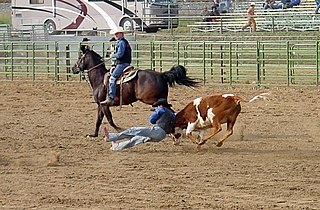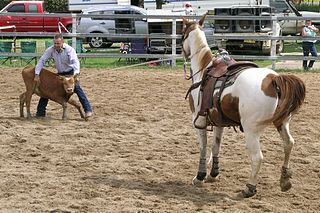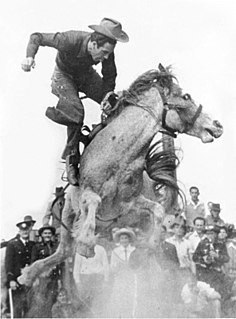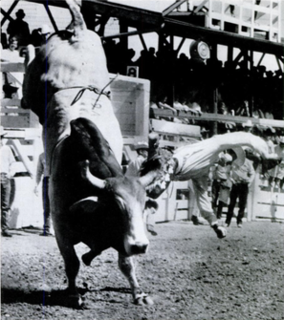
Equestrianism, commonly known as horse riding or horseback riding, includes the disciplines of riding, driving, and vaulting. This broad description includes the use of horses for practical working purposes, transportation, recreational activities, artistic or cultural exercises, and competitive sport.

Rodeo is a competitive equestrian sport that arose out of the working practices of cattle herding in Spain and Mexico, expanding throughout the Americas and to other nations. It was originally based on the skills required of the working vaqueros and later, cowboys, in what today is the western United States, western Canada, and northern Mexico. Today, it is a sporting event that involves horses and other livestock, designed to test the skill and speed of the cowboys and cowgirls. American-style professional rodeos generally comprise the following events: tie-down roping, team roping, steer wrestling, saddle bronc riding, bareback bronc riding, bull riding and barrel racing. The events are divided into two basic categories: the rough stock events and the timed events. Depending on sanctioning organization and region, other events such as breakaway roping, goat tying, and pole bending may also be a part of some rodeos. According to Encyclopedia Britannica, the "world's first public cowboy contest" was held on July 4, 1883, in Pecos, Texas, between cattle driver Trav Windham and roper Morg Livingston.

A cowboy is an animal herder who tends cattle on ranches in North America, traditionally on horseback, and often performs a multitude of other ranch-related tasks. The historic American cowboy of the late 19th century arose from the vaquero traditions of northern Mexico and became a figure of special significance and legend. A subtype, called a wrangler, specifically tends the horses used to work cattle. In addition to ranch work, some cowboys work for or participate in rodeos. Cowgirls, first defined as such in the late 19th century, had a less-well documented historical role, but in the modern world work at identical tasks and have obtained considerable respect for their achievements. Cattle handlers in many other parts of the world, particularly South America and Australia, perform work similar to the cowboy.

Bull riding is a rodeo sport that involves a rider getting on a bucking bull and attempting to stay mounted while the animal tries to buck off the rider.

Steer wrestling, also known as bulldogging, is a rodeo event in which a horse-mounted rider chases a steer, drops from the horse to the steer, then wrestles the steer to the ground by grabbing its horns and pulling it off-balance so that it falls to the ground. The event carries a high risk of injury to the cowboy. There are some concerns from the animal rights community that the competition may include practices that constitute cruelty to animals, but the injury rate to animals is less than five-hundredths of one percent. A later PRCA survey of 60,971 animal performances at 198 rodeo performances and 73 sections of "slack" indicated 27 animals were injured, again approximately five-hundredths of 1 percent – 0.0004.

Team roping also known as heading and heeling is a rodeo event that features a steer and two mounted riders. The first roper is referred to as the "header", the person who ropes the front of the steer, usually around the horns, but it is also legal for the rope to go around the neck, or go around one horn and the nose resulting in what they call a "half head". Once the steer is caught by one of the three legal head catches, the header must dally and use his horse to turn the steer to the left.

Calf roping, also known as tie-down roping, is a rodeo event that features a calf and a rider mounted on a horse. The goal of this timed event is for the rider to catch the calf by throwing a loop of rope from a lariat around its neck, dismount from the horse, run to the calf, and restrain it by tying three legs together, in as short a time as possible. A variant on the sport, with fewer animal welfare controversies, is breakaway roping, where the calf is roped, but not tied.

Charrería is a sport and discipline arising from equestrian activities and livestock traditions used in the haciendas of old Mexico.

Rodeos have long been a popular competitor and spectator sport in Australia, but were not run on an organised basis until the 1880s.

Lethem is a town in Guyana, located in the Upper Takutu-Upper Essequibo region. It is the regional capital of Upper Takutu-Upper Essequibo.
The Raymond Stampede is an annual rodeo that is held in the town of Raymond, Alberta, Canada every 1 July.

Western riding is considered a style of horse riding which has evolved from the ranching and welfare traditions which were brought to the Americans by the Spanish Conquistadors, as well as both equipment and riding style which evolved to meet the working needs of the cowboy in the American West. At the time, American cowboys had to work long hours in the saddle and often over rough terrain, sometimes having to rope a cattle using a lariat, also known as a lasso. Because of the necessity to control the horse with one hand and use a lariat with the other, western horses were trained to neck rein, that is, to change direction with light pressure of a rein against the horse's neck. Horses were also trained to exercise a certain degree of independence in using their natural instincts to follow the movements of a cow, thus a riding style developed that emphasized a deep, secure seat, and training methods encouraged a horse to be responsive on very light rein contact.
History of rodeo tracks the lineage of modern Western rodeo.

A stock horse is a horse of a type that is well suited for working with livestock, particularly cattle. The related cow pony or cow horse is a historic phrase, still used colloquially today, referring to a particularly small agile cattle-herding horse; the term dates to 1874. The word "pony" in this context has little to do with the animal's size, though the traditional cow pony could be as small as 700 to 900 pounds and less than 14 hands high.
Chute dogging is a rodeo event related to steer wrestling, in which the steer used weighs between 400 and 500 pounds. However, the competitor starts the event in a roping chute with the steer as opposed to grabbing onto the steer from horseback. The event is designed to give novices a chance to prepare for steer wrestling.
Reg Kesler began his rodeo career at the age of 14 at the Raymond Stampede, competing in the boys steer riding. At the time, it was common for cowboys to compete in many or even all the rodeo events, and Kesler was no exception as he grew into his rodeo career. He participated in all five major rodeo events of the time: saddle bronc riding, bareback riding, bull riding, tie-down roping and steer decorating, a precursor to steer wrestling. Kesler especially excelled in the roughstock events, namely saddle bronc riding and bareback riding, appearing in the top four in the Canadian standings in those events six times. He was also a successful competitor in the wild cow milking and wild horse racing, an outrider in the chuckwagon racing, and a well-known pick-up man. Kesler was a ProRodeo Hall of Fame and Canadian Pro Rodeo Hall of Fame inductee.

Historically, women have long participated in the rodeo. Annie Oakley created the image of the cowgirl in the late 19th century, and, in 1908, a 10-year-old girl was dubbed the first cowgirl after demonstrating her roping skills at Madison Square Garden. Women were celebrated competitors in bronc and bull riding events in the early decades of the 20th century until a female bronc rider died in a 1929 rodeo. Her death fueled the growing opposition to female competitors in rodeo; their participation was severely curtailed thereafter.

A stock contractor is an individual or business that provides animals for rodeo competition. Stock contractors supply roughstock - horses for saddle bronc and bareback bronc riding and bulls for the bull riding event, plus steers for steer wrestling and team roping, plus calves for calf roping events. Use of stock contractors who specialize in providing these animals has produced a more uniform range of bucking stock which are also quieter to handle.
A ranch rodeo is a traditional type of rodeo in which teams of cowboys or cowgirls from different ranches compete against each other in events based on the type of work they do every day.

V-61 was a hall of fame bucking bull known only by his brand, V-61. In 1970, he was the Bucking Bull of the NFR. In 2012, the Texas Rodeo Cowboy Hall of Fame inducted V-61. In 2015, the Bull Riding Hall of Fame inducted him into its inaugural class. In 930 attempts, only four bull riders managed to complete rides on him for a total of five qualified rides. His owner retired him in January 1974 and he died later that year.

















